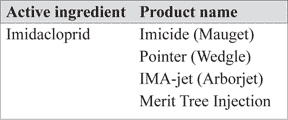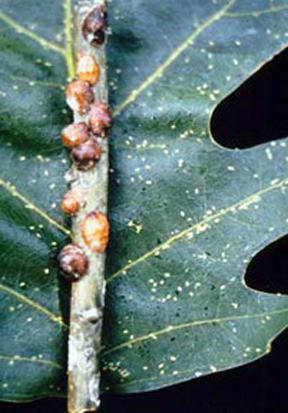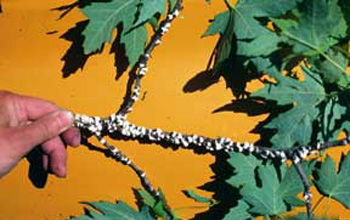A big year for outbreaks of soft scales in Michigan
Editor’s note: This article is from the archives of the MSU Crop Advisory Team Alerts. Check the label of any pesticide referenced to ensure your use is included.
Lecanium scale, calico scale and cottony maple scale are covering branches of silver maple, honeylocust and many other species of hardwood trees in southeast Michigan, the Saginaw Valley region, and a few other parts of the state. The biggest problem comes from the droplets of honeydew raining down from infested trees in May and early June. Eggs have formed under female lecanium scales in the Detroit area, and should be forming soon under calico and cottony maple scale females. Once the eggs form, the female stops feeding and the rain of honeydew subsides until later in the summer when the next generation begins to develop. Honeydew is the sugary liquid waste excreted by scale insects. A considerable amount of honeydew is excreted because scale insects need to suck lots of sap from trees in order to get the amount of protein they need for growth and development. This creates a large excess of sugars that are excreted in the honeydew. Honeydew rain is particularly annoying when branches of infested trees are over decks or parked cars. The scale infestations rarely damage trees, even when the trees are very heavily infested. In Saginaw and Bay counties where the mosquito spray programs suppress predators and increase the intensity of scale outbreaks, we sometimes see trees that become thin and experience branch dieback.
For some tips on insecticide management of lecanium scale and cottony maple scale, I talked to Dave Sutton, a Tri-City Tree Doctor, about his test trials with different insecticide treatments in Saginaw and Bay counties. Until a few years ago, he relied on using acephate (Orthene) or pyrethroid insecticide sprays at peak crawler emergence in mid-June to early July for scale control. More recently he has had better success with imidacloprid or imidacloprid/acephate trunk injections. Dave prefers to use the Arborjet trunk injection system, but several other trunk injection products are also available (Table 1). Spring trunk injections of imidacloprid have not given very good control of the large female scales in May or early June, but they give excellent control of the next generation of crawlers and young scales that settle on the leaves in July and August. That is why he injects both acephate and imidacloprid in May, because the acephate controls the females feeding in May and June, and the imidacloprid controls the young scales during the summer. In order to do this, the acephate is injected first because it is taken-up rapidly. After the acephate goes in, the lines are cleaned and then imidacloprid is injected through the same ports. More information is available at his website: www.tree-doc.com. When the rain of honeydew stops in the next two to three weeks, there will be little benefit to using acephate, and the imidacloprid can be used by itself.
Another treatment option that Dave Sutton likes to use is adding an imidacloprid basal drench (or basal soil injection) to the imidacloprid/acephate trunk injection. He feels confident in achieving long term soft scale control when the trunk injections/drenches are followed with basal drenches alone each year afterwards.
Table 1. Imidacloprid trunk injection products

Note: This information is for educational purposes
only. Reference to commercial products or trade
names does not imply endorsement by MSU
Extension or bias against those not mentioned.

Lecanium scale. Photo credit: Vermont Extension Service

Cottony maple scale. Photo credit: University of Georgia.
Dr. Smitley's work is funded in part by MSU's AgBioResearch.



 Print
Print Email
Email




